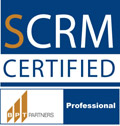Since Paul Greenberg put a stake in the ground in 2009, there has been lots and lots of posts, articles and discussions regarding Social CRM. Only in my blog I’ve published way more than 25 pieces.
A number of companies (P&G, KLM, giffgaff, Intuit, BestBuy abroad or Telecom Italia, Vodafone, H3G, Intesa Sanpaolo in Italy to name just a few) has been experimenting with social channels to nurture community based, peer-to-peer interactions integrated with traditional enterprise systems of record.
After having reached a first adoption level with some well-known visible stories, many corporations are now looking for the next step: industrializing, scaling up, moving from experimental pilots to company-wide assets where customer’s conversations can be systematically captured, responded and analyzed to improve market, sales, service and innovation effectiveness.
The recurring question is: how to do that? What’s the best process? What is needed to walk the talk?
Talking about strategic, cultural, organizational and technical evolution, a single recipe cannot fit with every company and business context. By looking at the most successful examples, I feel anyway some broad guidelines are emerging especially regarding the core consulting competencies needed to design and execute the outside-in shift Social CRM is representing.
Here it is my stub (click to enlarge):
Before looking at the list, it is very important to restate the end goals of this journey to me:
- Discovering the customer’s expectations, behaviors and job to be done regarding your brand / products / services
- Understanding how well or bad the cross-touchpoints (both online and offline) experience you provide matches with such expectations
- Evolving your internal processes / capabilities / systems not so much to build a relationship (who cares about that?) but more to co-create value with your customers by reducing the gap between experiences and expectations
- Think: this is where you define the overall strategy to go from high level business goals to a series of detailed objectives, actors, activities, technologies, metrics, success factors, constraints and smoothly put together all the following pieces according to the needs and peculiarities of the project.
- Analyze: here the motto is understanding what your customer is hiring you (or your product / service) to do and it means at least 3 things:
- Studying traditional online / offline touchpoints (focus groups, survey, market research, feedback management, voice of the customer, etc) and customer satisfaction with them
- Making sense of online conversations and behaviors to move from segments to tribes and to understand how much the new channels matter to your business
- Leveraging service design to map the 360° customer journey both from a functional and emotional perspective and rethink your processes, channels, overall customer experience accordingly
The goals of the project must be matched and weighted against the expectations of the entire company’s ecosystem through analytical capabilities. That means the thinking guides the analysis and the analysis informs the thinking. The competencies requested are anyway diverse.
- Change: understanding is not enough if you don’t have the will, the power and the tools to change or better to co-create change. Here the change should happen both externally, in the way the entire company ecosystem is engaged, and internally by leveraging communities to socialize and evolve existing processes, customer facing processes in particular. You cannot co-create with customers if your people are not involved, if you are not open, transparent, engaged internally. There’s no Social CRM without an Enterprise 2.0, under a common vision. For all this, change requires:
- Customer Engagement Capabilities such as digital / social strategy, monitoring, marketing, community management plus more traditional competencies on the web, mobile, advertising, software development
- Internal Transformation: first of all the evolution of your CRM processes to take advantage of new channels and approaches (yes deep CRM expertise not Social something) but also the ability to execute a sustainable change management that must necessarily be centered on human beings, inclusion, involvement, again.. engagement and co-creation but putting employees first
- Integrate: the last step to let the rubber meet the road is conceptually and technically integrating social in existing systems and processes. It may be the evolution of your CRM to map records and social identities, to attach online conversations to customers ID, to do business intelligence on them, prioritizing support based on the influence and reach of individuals, to bring community created answers back to your knowledge base. In any case Social CRM is not about communities or social networks. It is about leveraging them only where it makes sense to the business for improving the business and co-generating value for all the constituents inside, across and outside the company boundaries.
To recap, to me Social CRM is about changing the head, heart and soul of your business through market and customer insight, service design, external and internal transformation, technological integration.
As you can easily see, this traditionally means not just different competencies but more different companies still not talking to each other. Disregarding who is providing similar capabilities, I believe we need all of them to successfully reach the end of this journey and enable transparent value co-creation.
Am I missing the point? If it is all wrong, why? Does this list leave out central competencies?
Looking forward to hear from Mark Tamis, Andrea Incalza (I’m sure they will have something to add), Esteban Kolsky (service design is crap, there’s no journey?), Graham Hill (is co-creation cited enough times 🙂 ?), Mitch Lieberman and all those reading.
Update: the post and diagram have been slightly modified following Esteban Kolsky’s and Graham Hill’s comments here and on Twitter in order to make the connection between thinking and analyzing more clear. In any case the post is not meant to present a process or a series of steps but only a set of competencies to be orchestrated through a separate process.
This post is also available in: Italian

